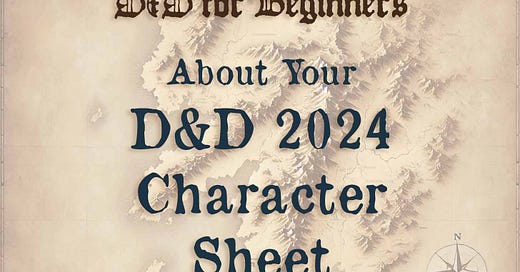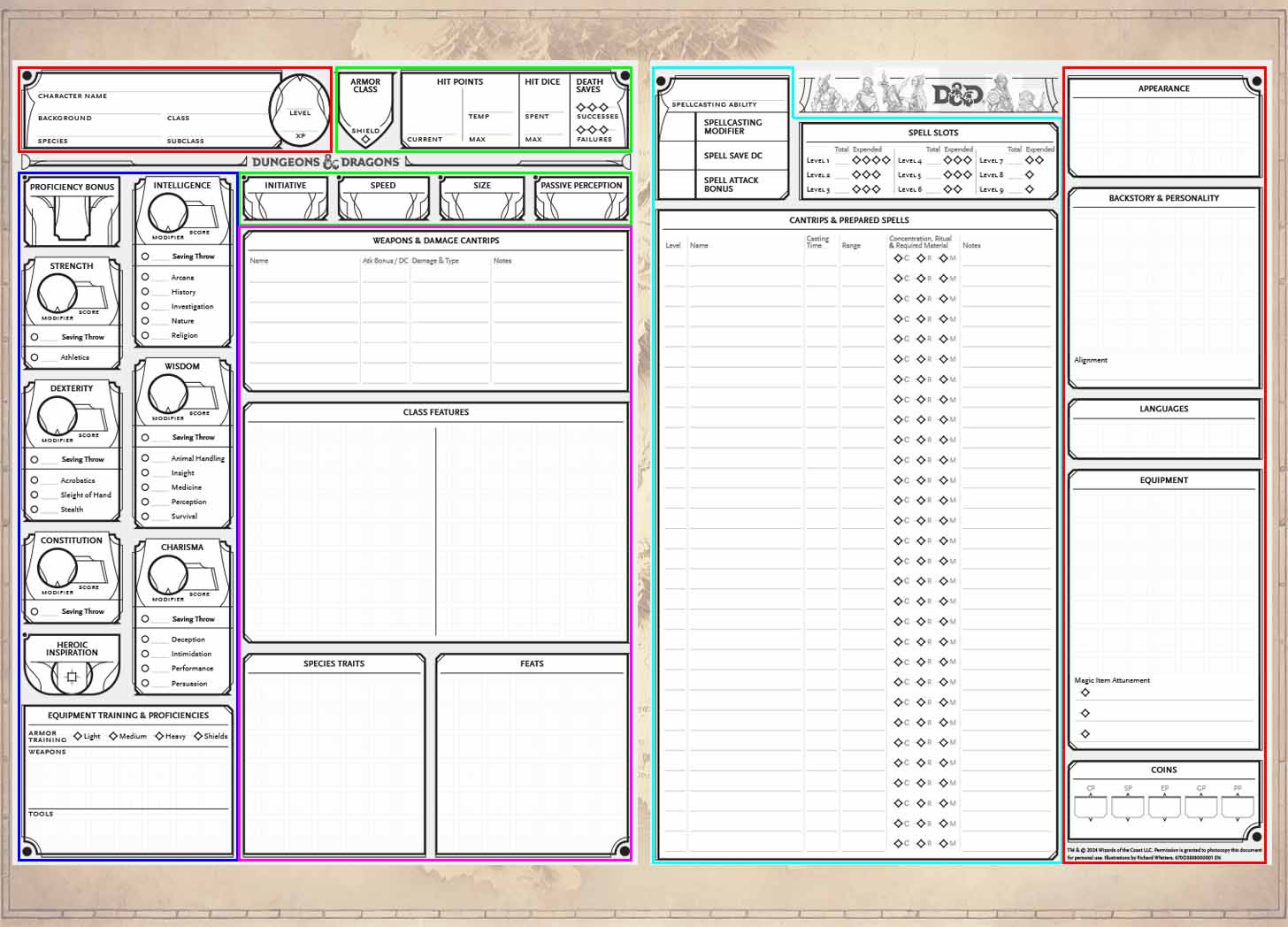Confusion Isn't Fun
A Map to Your D&D 2024 Character Sheet—making sense of the chaos before the dice start rolling
Download the new Dungeons & Dragons 2024 character sheet free at D&D Beyond — which, by the way, is an excellent tool and resource worth exploring. We’ll get into the tools aspect in another post.
So you've got your new D&D character sheet in front of you, staring at it like it's a tax form from some other dimension. Don't worry — I got you. It’s much less intimidating than it looks.
This isn’t about crunching numbers — yet. Right now, we’re just making sense of what is where, like a map legend that tells you what’s what.
I’ve found one of the more stressful situations for a new player to be in is having to figure out where something is on the character sheet… while the rest of the table stares at them, waiting. My goal is to give you an understanding of what each section means in general so you’re not utterly lost when the game starts.
The two-page character sheet is well designed, grouping related items together. So, let’s break it down into logical chunks — starting at an unexpected place: the top of the first page.
Page 1, Header Row (red & green)
Left Side: Who You Are
Before you swing a sword or cast a spell, you need to know who you are. This section defines your character’s origins and identity. It’s basically the character’s in-game ID card. These details are the foundation for everything you’ll do in the world of D&D.
Character Name – Your alter ego in the world of swords & sorcery. Feel free to get creative.
For example, I, the esteemed Professor Lump Crackfang (but I prefer “Richard”), go on daring adventures every two weeks with Sir Tinly Smallwong, Algonquin J. Calhoun, and Aaron Bender III (the last Aaron Bender) among others.Class & Level – This is what kind of adventurer — paladin? cleric? rogue? sorcerer? — you are and how much experience you've racked up as that sort of adventurer.
Species – Elf? Dwarf? Dragonborn? This tells you what kind of fantasy being you are.
Background – This is what you did prior to becoming an adventurer. Were you a pirate? a bounty hunter? a noble? It gives you certain skills, equipment, and proficiencies.
XP (Experience Points) – In some games, depending on how your Dungeon Master (known as the DM) has structured the game, you track XP to know when you level up. In some DM’s games, you level up after certain milestones are achieved, so you won’t track your XP.
One bit of advice for the game table: Write in pencil. You’ll be erasing and rewriting quite a bit as you play the game.
Right Side: How Tough You Are
No adventurer is invincible. Whether you’re dodging fireballs, taking hits from a troll, or clinging to life by a thread, this section tracks your physical resilience. When the dice turn against you, this is where you’ll look to see how much trouble you’re in.
When the DM says, “Roll initiative,” this section matters.
Armor Class (AC) – How hard it is for enemies to hit you. Higher = harder to hit.
Hit Points (HP) – Your life force. Think hearts in Legend of Zelda. Run out, and you’re in serious trouble.
Hit Dice (HD) – Don’t sweat this. Your DM will explain it. Used to regain HP during short rests.
Death Saves – When you hit 0 HP and aren’t “kilt d-e-d” immediately, you’re unconscious. These dice rolls determine whether you survive or die.
Initiative – When sh!t goes south (or straight into the fan), roll a d20, add this number, and tell the DM your total.
Speed – Your normal walking speed, usually in feet. It shows how far you can move on your turn. If your group uses a battle map and figurines, you might prefer to write this as a number of squares (30 feet = 6 squares on most battle maps).
Size – Your size relative to humans. For most species, this will be medium.
Passive Perception – Your ability to notice things when you aren’t actively looking. It’s mainly a number that is useful for the DM to be aware of.
Page 1, Left ⅓-width Column (blue)
What You Can Do
This section determines what your character is naturally good (or bad) at. Whether you're a burly pit fighter who can bench-press an ogre or a sneaky thief who never gets caught, these stats shape your strengths, weaknesses, and everything in between.
Proficiency Bonus – This is a number that gets added to a die roll that reflects the fact that you are trained in using a particular skill or tool. This number usually starts at 2 and increases as your adventurer becomes more experienced.
Ability Scores – These numbers represent your character’s natural talents or weaknesses. They’ll generally range from about 6 to 18 — they are dice rolls — when you start adventuring. Higher is better.
Ability Modifiers – Each ability score results in a modifier that gets shown in the circle to the left of the score. The modifier (not the score) is what really matters in gameplay.
Saving Throws – Within each ability box is Saving Throw. That is how well you resist things like mind control, poison, or dodging a dragon’s fire breath. For a couple of them, you’ll have a dot next to it indicating you’re proficient in dodging that type of hazard, so you can add your Proficiency Bonus (above) to the die roll.
Skills (Acrobatics, Stealth, Persuasion, etc.) – Within each ability’s box, below the saving throw, is a list of skills related to that ability. These are the things your character is really good — or really sucks — at. You’ll have a dot next to a handful of them, meaning you are proficient at that skill, so you can add your Proficiency Bonus (above) to the die roll.
Heroic Inspiration – The DM can award Heroic Inspiration to you, the player, for doing things that make the game more enjoyable or memorable for everyone at the table. It is a game mechanic that allows for rerolling a 20-sided die once.
Equipment Training & Proficiencies – The gear you’re trained to use — armor, weapons, tools, and musical instruments — which lets you add your Proficiency Bonus (above) to the die roll.
Page 1, Right ⅔-width Column (purple)
Fighting Gear
These are your everyday damage-dealing tools. Weapons are… well, weapons, like a bow & arrow or sword or your fists. If your character uses magic, cantrips are a type of spell. Cantrips are spells you know so well that you can cast them over and over. Some cantrips deal damage, some repair damage, and some are utility (like making something glow). The cantrips that deal damage go here.
This section is your go-to for combat. It lists...
the weapon or cantrip
the number you add to the die roll to see if your attack hits (an attack bonus) or the number an enemy has to roll to avoid your cantrip (a difficulty class or DC)
the amount and type of damage the weapon or cantrip deals if you hits the bad guy
any special notes about it
What Makes You Special
This is where your character stands out. Maybe you’ve got a signature move, a powerful class feature, or a racial trait that gives you an edge. These are the things that make your adventurer more than just another sword-swinging, spell-slinging wanderer — they make your character unforgettable at the table.
Class Features – Special abilities you get from your class, like a Rogue’s Sneak Attack.
Feats – Extra perks you might get as you level up.
Species Traits – Cool stuff based on your race/species. Elves don’t need sleep, for example.
Page 2, Left ⅔-width Column (cyan)
Spells & Spellcasting
If your character slings magic, this entire block is where you track your spells, spell slots, and magic attacks. Using spells and tracking spell slots gets a bit involved, so I’ll cover that in another post. For now, just know that everything spell-related can be found here.
Page 2, Right ⅓-width Column (red)
Who You Are Beneath the Stats
This column is “flavor” — stuff that gives your character a bit of depth and makes them come alive in the story world.
Stats and abilities define what you can do, but this section defines who you are. This area covers the essence of your character beyond mechanics—what drives them, how they think, and what makes them unique. What do they fear? What’s their go-to tavern order? These details add depth and make roleplaying a whole lot more fun.
Appearance – How your character looks.
Backstory & Personality – Your character’s history, motivations, and personal quirks. What makes them tick? Nervous around royalty? Always tells dad jokes?
Languages – What your character can understand and speak. Because knowing Draconic is cool.
Equipment – Your inventory. To save space, you may not have listed weapons here, since they are listed under Weapons & Damage Cantrips on the first page. This section is for everything from rope to torches to your lucky owlbear claw.
Coins – How much copper, silver, electrum, gold, and platinum is jingling in your pocket.
Now What?
Now, when you look at your character sheet, it won’t feel like a foreign language. You’ll know what each section means. When you sit down at the table, you’ll have a better grasp of where to find what you need quickly — so you can focus on playing rather than frantically flipping your sheet over and back in confusion.
Eventually, we’ll go beyond mapping the sheet and dive into filling it in.
Until then, may your dice roll high and your character stay on the right side of the dirt!
-- Dick Crackfang, A.W.E. (Arcane Wizard Extraordinaire)




